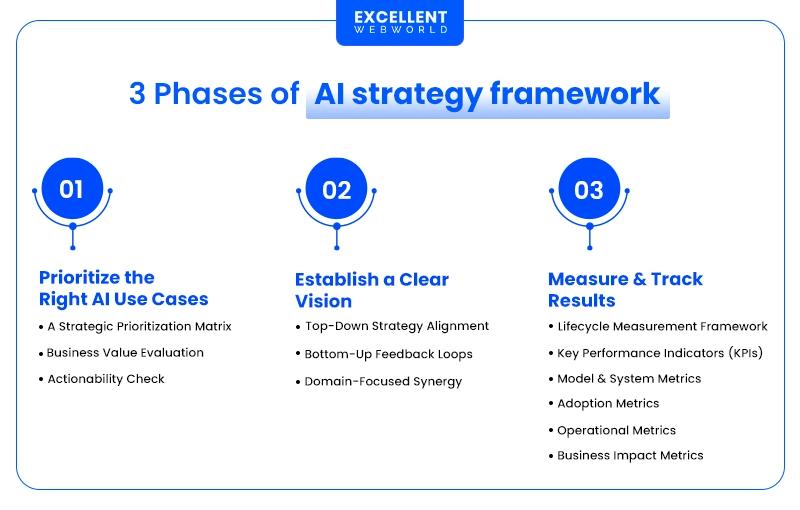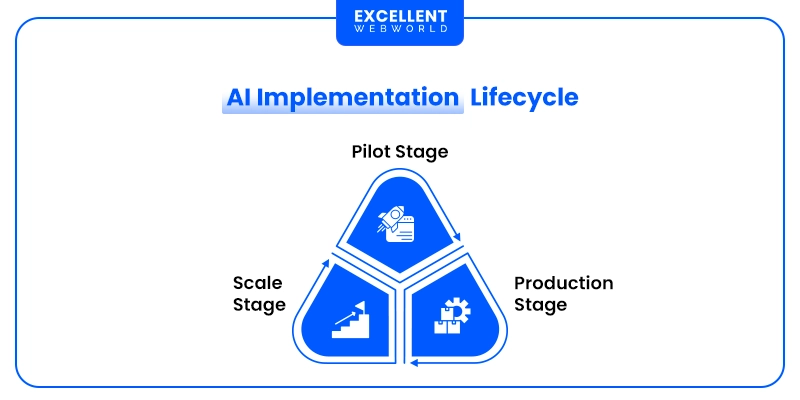AI has gained momentum in technology, turning experimental hype into a real game-changing situation. With over 80% of enterprises planning to adopt generative AI, it marks a significant leap for the AI race. But here is the main catch: only the organizations with an actionable AI strategy are getting a good ROI value.
So, if you ask, what is AI strategy? – Simply put, it is a structured game plan that mainly leverages AI to resolve real problems, create value, and scale innovation.
And yet, despite widespread AI initiatives, many organizations fall short. Why? Because they treat AI as fragmented implementations involving isolated pilots, misaligned initiatives, and a lack of direction. This is the AI gold rush, where there is higher investment without alignment.
To break this cycle, you need more than experimentation, you need a strategy rooted in business outcomes. In this blog, we’ve done exactly that, laying out a scalable AI strategy framework and a roadmap to real business value. You’ll learn:
With the right guidance, your artificial intelligence strategy can become a competitive advantage for your business. Let’s deep dive into how to build an AI strategy framework.
Phase 1: Establish a Clear AI Strategy Vision for Enterprise Business Success
It is important to have a clear understanding of AI strategy aligned to your business goals before diving into AI tools and technology. With a clear and purpose-driven vision in AI strategy, organizations can align the innovations with great value-especially while focusing on an effective AI integration in software development for better outcomes.
A successful strategic AI implementation can establish broader AI potential and new possibilities that drive your business with full scalability and much better productivity.
Understanding Top-Down AI Strategy Alignment with Business Objectives
With a stronger enterprise AI strategy, there is a great alignment between AI goals and business vision. Defining how AI domains like supply chain, marketing, or finance help you to map out your business objectives. Understanding how to build an AI strategy ensures that the alignment is intentional, bringing much clarity, reducing unnecessary resources, and also making the AI business focus on high-impact outcomes.
Strategic clarity can reduce waste by mainly eliminating guesswork, ensuring that AI resources and expertise are utilized based on the business goals. This approach also helps optimize the AI development cost by preventing expensive trial-and-error approaches. Collaborating with the IT project management consulting services can streamline your work process, avoiding duplication & misaligned projects.
Leveraging Bottom-Up Feedback Loops in AI Strategy Planning and Implementation
So, this deals with the AI strategy framework that gathers insights and improves the models from the end user perspective. Teams often overlook the AI opportunities, but by incorporating a feedback process, they can reveal data issues and gaps at an early stage, which gives a smarter AI strategy planning.
This approach not only improves the model performance, but also helps you to build an AI strategy that is adaptive and smart for the real user needs. For example, in retail, when there are frequent stockouts of their popular items, real-time inventory or an AI-powered algorithm can give real-time data analytics, preventing out-of-stocks.
Creating Domain-Focused Synergy for Strategic AI Success in Digital Transformation
In an AI-powered organization, isolated use cases underdeliver as they operate in silos with limited capability & scalability. This can be changed with AI initiatives that are connected across different domains like marketing, sales, and operations. With this cross-domain integration as a multiplier, AI creates a greater value. Engaging with business IT consulting services can help you design cross-domain integration, transforming ideas into valuable results.
Additionally, cluster mapping can create a smart AI use case personalization by grouping related AI technologies & applications into clusters. As a result, it promotes collaboration, innovation, and maximizes enterprise-wide value when paired with strategies like building an AI agent tailored to your needs.
Phase 2: Prioritize & Plan the Right AI Use Cases for Maximum ROI
This phase focuses on identifying and prioritizing high-impact opportunities, specifically generative AI use cases in software development that align with your AI strategy framework and effectively support both ai initiatives and broader business goals.
Using a Strategic Prioritization Matrix for AI Business Strategy
This involves utilizing a matrix to measure business value, feasibility, and actionability. Focusing on this can help you create an AI strategy template. As a result, this can also help you to visualize the priority zone based on high value, high feasibility, and actionable insights of the projects.
To turn this strategy into proper execution, there is a need for a technical team that aligns with the strategic approach. Embracing the Vibe Coding mindset, hiring Vibe coding developers can ensure that your AI initiatives are implemented with agility & domain expertise.
It is a critical tool in any kind of effective AI strategy template that offers guided and impactful AI strategies. With this generative AI strategy, organizations can accelerate their ROI without any wasted efforts.
Evaluating Business Value and ROI in AI Strategy Development and Implementation
This evaluation tends to analyze whether it shifts the key business metrics or not. Also, it raises questions like, “Does it align with your AI in business strategy?” or “Can it scale across teams?” – The simple answer to it is building a sustainable artificial intelligence plan, one that is based on well-defined artificial intelligence business strategies and applications. This lets you have a full grasp of the AI implications for your business strategy. Partnering with a software development consultant at this stage can help you gain a full grasp of the AI implications for your business strategy.
Actionability Check: Ensuring AI Use Cases Align with Enterprise Goals
This generally analyzes whether your teams can generate ROI or easily implement the solution or not. With these conditions, it is simply clear whether you are developing an AI solution or just building for the sake of it.
An actionability check to build an AI strategy involves assessing various factors like strategic alignment, stakeholder buy-in, and the potential impact on the business. These checks ensure that your artificial intelligence plan is aligned with your focused results and forms a significant part of developing an AI. Partnering with an experienced AI consulting services company can help you prioritize urgent issues, integrate smoothly, and drive ROI within weeks.
You can drive ROI faster by prioritizing urgent issues, integrating smoothly, and showing measurable results within weeks in your business, mainly when you follow a strategic approach to building an AI app as per business needs.
Phase 3: Measure and Track AI Strategy Results and KPIs
An effective AI strategy not only involves deployment, but with an AI business strategy, it focuses on tracking the results with a solid AI strategy plan. Aligning with the metrics, strategic AI enables leaders to ensure that AI & business strategy evolve through data-driven AI strategy planning. Whether you’re building an AI roadmap or embracing AI-assisted software development, understanding how to build an AI strategy is crucial for navigating these phases effectively and leveraging AI for business strategy to ensure long-term success.
Let’s explore the phases.
Lifecycle Measurement Framework for AI Strategy Execution
An effective artificial intelligence implementation lifecycle starts with the pilot to production for scaling that offers longer-term value. Successful organizations often adopt proven AI frameworks to standardize their measurement processes and ensure consistent evaluation across all phases of deployment.
To truly develop an AI solution, it is important to have a full lifecycle view backed by continuous optimization and strategic planning. A well-planned AI implementation strategy can ensure that every phase, starting from deployment to scaling, is properly aligned with the business goals. Continuous optimization is said to be a key factor that helps you to assess your AI tool at every point, actively measuring the performance with iterative improvements.
Let’s explore the lifecycle overview.
Key Performance Indicators (KPIs) for AI Success
To ensure that your business has an AI strategy that drives real outputs, you should track KPIs that are related to the business value. As a part of an effective AI strategy development, you should focus on the leading indicators, like user engagement, and lagging indicators, like revenue growth, to analyze performance. These metrics enable you to validate the artificial intelligence and business strategy relation and enhance AI business value metrics.
Tracking AI Model & System Performance Metrics for Business Impact
So, it is important to know about the strong foundation behind every AI strategy for business. Tracking the reliability, identifying bias factors, and ensuring that scalability is maintained properly are critical parts of your machine learning strategy that help in establishing a strong AI strategy framework. Infrastructure health and spotting bottlenecks at a very early stage help you in building artificial intelligence implications for business strategy.
Adoption Metrics to Measure User and Organizational Buy-in for AI Initiatives
User adoption is the most crucial thing, without which even the smartest AI isn’t able to succeed. You should track the user interaction with the AI tools by tracking usage frequency, gathering feedback, and evaluating the training impact. With a strong adoption rate, one can easily turn an AI strategy example into a higher-scale output. This is quite vital when creating artificial intelligence that can support all the business needs.
Operational Metrics for Monitoring AI Strategy Implementation
These are also types of KPIs that help in analyzing the usage of AI functionalities. Start by monitoring the workflows to identify the silent failures or misalignments at an earlier phase; these operational metrics can refine any kind of AI strategy example. This ensures that your AI tool stays relevant while creating artificial intelligence systems.
Business Impact Metrics for Evaluating AI Strategies and ROI
Your AI business strategy must affect the bottom line, so measuring the increased revenue, cost savings, efficiency, customer experience, and risk mitigation helps in having a clearer picture. As a result, these metrics help in assessing the true value of artificial intelligence in business and can also give a clear answer to your question, like “How can you profit from AI?”
Now that you have an overview of how to build an appropriate AI strategy framework, let’s also see the drawbacks and the problems that can be avoided.
Common Pitfalls to Avoid in AI Strategy Development and Implementation
The common pitfalls and mistakes that you should keep in mind while you build your artificial intelligence roadmap:
While we conclude, let us have a final thought on this.
Final Thoughts: Building an Adaptive and Scalable AI Strategy with Strategic Foresight
AI is not just about a tech trend; it’s a total change in business operations. Having the right AI strategy, with clear-cut priorities and continuous feedback, businesses can transform their ideas into a lasting impact. The future belongs to businesses that prioritize AI as their core part, not just a side project.
For businesses that are aiming to transform their AI strategies into valuable results, partnering with the experts can bridge the gap between technology and business. Excellent Webworld, as a reliable generative AI development company, can offer you some comprehensive services that encompass everything from AI consulting to custom AI digital solutions. This facilitates higher scalability & ROI-focused AI digital solutions with skilled expertise.
Let’s turn your AI strategy into a measurable success story.
FAQs: Your Top Questions on AI Strategy Answered
AI strategy involves continuous learning, data-driven decisions, and other cross-functional alignment other than the static IT system.
Every quarter, it is necessary to adapt to input data, aligned business objectives, and AI advancements.
Yes, small businesses can benefit from this with optimized operations and also uncover new value associated with the business goals.
Vibe coding ensures faster deployment, aligning with the business goals through the integration of AI into the digital products supported by robust software development services, which prioritize scalability & innovations.
Yes, it can improve by enabling personalization, faster services, and predictive analytics.

Article By
Paresh Sagar is the CEO of Excellent Webworld. He firmly believes in using technology to solve challenges. His dedication and attention to detail make him an expert in helping startups in different industries digitalize their businesses globally.





